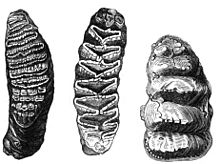Molar (tooth)
Therian mammals (placentals and marsupials) are generally agreed to have evolved from an ancestor with tribosphenic cheek teeth, with three main cusps arranged in a triangle.[2] Each major cusp on an upper molar is called a cone and is identified by a prefix dependent on its relative location on the tooth: proto-, para-, meta-, hypo-, and ento-.In tribosphenic teeth, the lower molar is divided into two regions: the three-cusped trigonid, or shearing end, and the talonid, or crushing heel.Many paleontologists argue that it developed independently in monotremes (from australosphenidans), rather than being inherited from a common ancestor that they share with marsupials and placentals (from boreosphenidans); this idea still has some critics.[8] Hypsodont dentition is characterized by high-crowned teeth and enamel that extends far past the gum line, which provides extra material for wear and tear.[3][11] In zalambdodont placentals, the larger inner cusp is homologous with the paracone in a tribosphenic upper molar, while the metacone is absent, reduced or fused.Marsupial moles show the opposite condition, with the large cusp equivalent to the metacone, and the paracone absent instead.In the lower molars, the talonid region is reduced or absent, having lost its role as a crushing basin against the protocone.[7] Lophodont teeth are easily identified by the differentiating patterns of ridges or lophs of enamel interconnecting the cusps on the crowns.Present in most herbivores, these patterns of lophs can be a simple, ring-like edge, as in mole rats, or a complex arrangement of series of ridges and cross-ridges, as those in odd-toed ungulates, such as equids.[8] Lophodont molars have hard and elongated enamel ridges called lophs oriented either along or perpendicular to the dental row.In selenodont molars (so-named after moon goddess Selene), the major cusp is elongated into crescent-shaped ridge.








Molar (unit)Molar (disambiguation)wisdom toothArteryPosterior superior alveolar arteryAnatomical terminologymammalsgrind foodchewingmillstonevestigialDental anatomyHuman toothmaxillary first molarmaxillary second molarmaxillary third molarmandibular first molarmandibular second molarmandibular third molarMammal toothCingulacheek teeththerapsidTherianpelycosaurcynodonteucynodontSpalacotheriumsymmetrodontAmphitheriumprototribosphenidGlossary of mammalian dental topographycinguluminsectivorousplatypusesmortar and pestlemonotremesaustralosphenidansmarsupialsplacentalsboreosphenidansEarly CretaceousSteropodonPeramusdryolestoidsJurassicmammalia formsdocodontsshuotheriidsconvergent evolutionhypoconehedgehogsraccoonsprimateschimpanzeeHypsodontcattleArvicolinaegingivalinvaginatetenrecsgolden molessolenodonsmarsupial moleslambdasshrewsElephasLoxodontamastodonmole ratsodd-toed ungulatesequidstapirsmanateeslagomorphselephantsOtomysAfrican elephantselenodontSeleneEurasian wolfcarnassialsDental formulaPolyphyodontCharrier, ReynaldoBibcodeGlossary of dentistryUniversal Numbering SystemPermanentincisorcaninepremolarDeciduousMaxillaryCentral incisorLateral incisorFirst premolarSecond premolarFirst molarSecond molarThird molarMandibularCusp of CarabelliZuckerkandl's tubercleRoot canalApical foramenCementoenamel junctionEnamelDental-enamel junctionDentinDental papillaMamelonDental alveolus